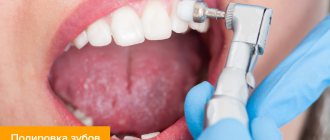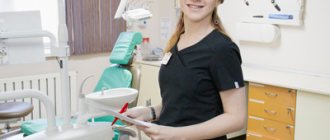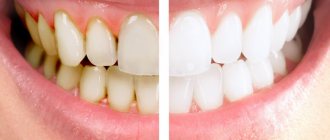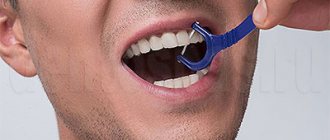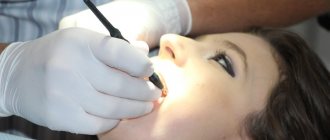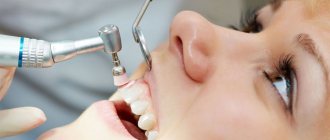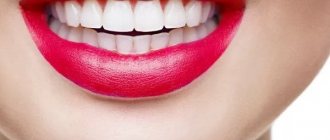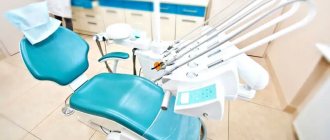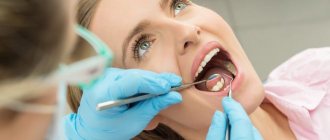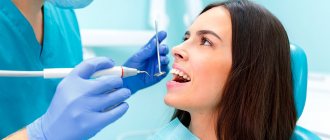- home
- For patients
- Articles
- Ultrasonic teeth cleaning before and after
Cleanliness, as we know, is the key to health.
But, unfortunately, it is impossible to achieve ideal teeth cleanliness with the help of toothbrushes and floss, even the most advanced ones. Soft plaque will inevitably accumulate in hard-to-reach places, turning over time into a denser formation - tartar. Its favorite place is the edge of the gum, where it forms a yellowish-brown edge, thereby preventing proper nutrition of the gum and mineralization of the tooth. If the stone is not removed in time, then sooner or later inflammatory diseases such as periodontal disease, gingivitis, and caries will appear. And here the reader may wonder - what kind of text is this, and where is the confirmation?
And here they are. Incredible stories happen everywhere, so a patient with very neglected teeth turned to the One to One dentistry on Voykovskaya:
Photo - the condition of the teeth at the time of contacting the One to One clinic
The situation cannot be considered hopeless if Lushnikova E.V., a periodontist-hygienist, is a true master of his craft.
All cleaning took place in several stages:
- Air Flow procedure to remove soft deposits and eliminate yellow plaque and age spots;
- ultrasonic cleaning – to remove tartar and subgingival deposits;
- treatment of gum inflammation.
Stages of comprehensive oral hygiene BEFORE and AFTER
Why is the procedure needed?
Professional teeth cleaning is a preventive and aesthetic procedure. It solves 7 problems at once:
- prevents the development of caries and inflammatory gum diseases;
- makes teeth whiter;
- carried out as preparation for complex dental treatment (implantation, bite correction, prosthetics);
- adds self-confidence;
- reduces the risk of complications after complex dental treatment;
- removes dark marks caused by coffee, cigarettes and food dyes;
- solves the problem of bad breath if it is caused by tartar.
During home brushing, mineralized plaque remains on the teeth. It can only be removed using professional tools and methods. Therefore, dental cleaning is a necessary procedure for anyone who wants to maintain healthy teeth.
How often should I clean?
Hygienic cleaning must be carried out every morning and evening. Professionally, the procedure is carried out once every six months. This is enough to maintain the result. Additionally, cleaning may be necessary before undergoing complex dental treatment or if you regularly drink coffee or smoke cigarettes.
.
Professional teeth cleaning: price
How much does professional teeth cleaning cost? The price for 2021 in economy class and mid-price clinics will average about 100 rubles per tooth (this includes cleaning and polishing).
For example, in the regions, at an all-inclusive rate, which includes removal of tartar + polishing of all teeth with AirFlow + fluoridation using a mouth guard with gel - cleaning costs approximately 2500–3500 rubles. In Moscow clinics, the price for “all inclusive” starts from 4,000 rubles, but if you do not have massive plaque, then simply polishing all your teeth with polishing brushes and paste will cost about 2,000 rubles.
Sources:
1. Add. professional
, 2. Based on personal experience as a periodontist, 3. National Library of Medicine (USA), 4. American Academy of Periodontology (USA), 5. “Therapeutic dentistry. Textbook" (Borovsky E.V.).
Types and differences
Professional teeth cleaning can be done in a variety of ways. Each of them has both advantages and disadvantages. The patient’s wishes are taken into account when choosing a technique, but the final decision is made by the doctor, taking into account contraindications and the condition of the teeth.
Ultrasonic
The most effective way to remove solid deposits is ultrasonic cleaning. With its help, tartar is removed. A special device is used for this: it can be built into the dental unit or made as a separate unit. This is an ultrasonic scaler.
There is a working nozzle at the tip of the device. Its tip makes oscillatory movements at an ultrasonic frequency of 25-50 kHz. Additionally, water or an antiseptic solution is supplied to the nozzle. They enhance the cleansing effect due to cavitation - vibrations of water dipoles with the formation of bubbles. Excess fluid is removed using a saliva ejector.
Ultrasonic cleaning, when carried out correctly, does not damage the enamel. It allows you to remove not only tartar, but also bacteria due to the supply of an antiseptic solution and the bactericidal effect of cavitation. Supra- and subgingival deposits are also removed. The procedure is absolutely painless and comfortable.
Laser teeth cleaning
Teeth cleaning with a laser is quick. The beam is directed onto the surface of the teeth, causing the water in the plaque to evaporate. Residues are washed off with a water jet under pressure.
Teeth cleaning with a laser requires expensive equipment. It is significantly higher in price than the others.
Sandblasting
Teeth cleaning by sandblasting is carried out using an Air Flow device. This is a modern and effective way to remove old plaque. For cleaning you need a device with attachments, a mixture of fine abrasive and a fixing gel. Cleansing powders are produced with pleasant flavors, which makes the procedure more comfortable.
Hygiene with Air Flow is not suitable for removing tartar. But the device copes well with old soft plaque. It does not harm enamel, but should be used with caution in people with sensitive gums.
Does it hurt to clean stones on your teeth?
The specific sensations of a particular patient depend on the method of cleaning the stone on the teeth and the individual sensitivity of the person. Everyone's pain threshold is different, so you shouldn't rely on other people's reviews. What may seem intolerable to someone else will remind you of a mosquito bite and vice versa.
Important. When choosing a method for removing stones from teeth, listen to your doctor’s recommendations. The dentist makes a decision based on the results of the examination - the condition of the enamel, the amount of deposits, predisposition or the presence of diseases such as periodontal disease and periodontitis.
Ultrasonic cleaning
Hard dental deposits can only be removed using an ultrasonic scaler. Under the influence of ultrasonic waves, the stones completely crumble, while the enamel remains intact. The procedure is practically painless, but with increased sensitivity, discomfort may occur. In this case, the doctor uses special anesthesia.
A slight pain may also occur when treating gum pockets. But the feeling is quite tolerable and lasts literally a fraction of a second. Ultrasonic cleaning is the only possible way to remove hard stones from pockets, and you should not refuse to do it. It is better to warn your doctor before the procedure that you have increased tooth sensitivity.
When treating areas with enamel, that is, the teeth themselves, pain, as a rule, does not occur.
The main advantages of the method include:
- ideal cleaning quality - the enamel becomes smooth and even;
- the ability to remove hard deposits from interdental spaces and hard-to-reach places;
- bactericidal effect - pathogenic microflora dies under the influence of ultrasonic waves, which reduces the risk of caries;
- optical effect - after removing brown spots and stripes, the enamel becomes visually lighter.
The procedure for removing tartar is mandatory before prosthetics, implantation, before installing braces, and other orthopedic manipulations. Hygienic cleaning with a scaler is also indicated in cases of periodontal disease and periodontitis, twice a year. In other cases, it is recommended to remove tartar with ultrasound once every 12 months.
The duration of the procedure depends on the condition of the patient’s teeth, but, as a rule, does not exceed 40-60 minutes. In especially severe cases, the doctor performs cleaning over several visits.
There are contraindications:
- severe heart disease, the presence of a pacemaker - the ultrasonic wave can disrupt the rhythm of the heart or the device;
- pregnancy - ultrasonic cleaning can negatively affect the development of the fetus, and also lead to miscarriage or premature birth;
- increased pathological sensitivity of the enamel - here we are talking not so much about the pain syndrome, but about the reaction of the body as a whole;
- rehabilitation period after operations and infectious diseases.
Another risk factor is childhood. You can remove stones from your teeth no earlier than two years after the last tooth erupts.
Important. It is not possible to remove hard plaque from teeth at home. In fact, the stone grows into the pores of the enamel, and even the hardest toothbrush is not able to remove it.
Laser removal
From a pain point of view, the procedure is considered completely painless. The laser beam completely destroys hard and soft deposits without affecting the enamel. Dentists recommend removing tartar with a laser in cases where cleaning of the gum pockets is not required. Perhaps this is the only drawback of the procedure.
After laser cleaning, the enamel becomes smoother, its resistance to external influences increases, and the likelihood of caries, gingivitis, and stomatitis decreases. The procedure takes no more than an hour. The main indication for laser stone removal is the presence of hard plaque on the teeth.
There are a number of contraindications - pregnancy, postoperative period, decreased immunity, infectious diseases. These also include untreated caries, a large number of fillings, and increased sensitivity of tooth enamel.
Laser stone removal is an expensive procedure.
Air-Flow
The procedure involves cleaning teeth from stone using a water-dispersed mixture under pressure. Small crystals remove soft plaque from the enamel, while simultaneously polishing it. The main advantage of the technique is a high degree of teeth cleansing even in the most difficult to reach places, including gum pockets.
Air-Flow is traditionally used in combination as a subsequent step after ultrasonic cleaning. As a result, teeth are completely cleaned of hard and soft deposits. The teeth become smooth, as if polished.
The special advantages of the method include:
- painlessness - the patient does not experience discomfort even with very sensitive enamel;
- excellent result - interdental spaces, gum pockets are perfectly cleaned, pigmentation is eliminated;
- natural whitening – by removing stains, teeth become one or two shades lighter;
- hypoallergenic - the mixture contains water, fine-crystalline soda, citrus fragrance.
The effect is especially noticeable for those who have orthopedic structures installed in their mouths - crowns, braces, veneers, implants. The procedure is also recommended for regular use by smokers and lovers of strong tea and coffee.
Removing stones from teeth using this method is contraindicated:
- patients with respiratory diseases - to avoid a possible attack;
- with thin enamel and pathological sensitivity of teeth;
- with caution during pregnancy.
The procedure is carried out in 30-40 minutes, while the patient experiences a feeling of comfort, which is facilitated by a light massage of the gums.
Complete cleaning of teeth and interdental pockets reduces the risk of caries to a minimum.
Chemical removal
It is also possible to clean off old tartar chemically - this method is now used extremely rarely, only in cases where ultrasound and air flow are powerless. A composition containing chemically active substances is applied to the enamel. Under their influence, the stone softens and is cleaned manually.
The method is painless, but is not recommended for thin enamel, increased tooth sensitivity and the presence of open carious cavities.
The second name of the procedure is chemical bleaching. The enamel becomes lighter by 3-4 tones.
Mechanical cleaning
The procedure is extremely unpleasant and is now practically not used anywhere. Hard tartar and soft plaque are removed with special metal spatulas. During the manipulation, there is a high risk that the doctor’s hand may slip and the instrument may damage the gums. The effectiveness of the method is in question, since it is not possible to completely remove deposits.
Dry cleaning
For professional hygiene, a special gel containing acid and hydrogen is applied to the teeth. The composition is kept for several minutes. Under the influence of chemicals, tartar is destroyed. It is then easily cleaned off with water.
The technique is painless and effective, but plaque in the interdental spaces cannot be removed in this way. The composition also has an adverse effect on the gums, so it is better not to use it for people with closely located vessels.
Mechanical teeth cleaning
The simplest method of professional dental hygiene. It is carried out using dental instruments, highly active pastes and brushes. This takes longer than other cleaning methods. There is a risk of damage to the enamel. Therefore, the mechanical method is used quite rarely.
Fluoridation of teeth
After professional cleaning, teeth are often fluoridated. It performs 4 functions:
- strengthens enamel;
- reduces tooth sensitivity;
- slows down the growth of bacteria;
- reduces the negative impact of an acidic environment.
To do this, the surface of the teeth is coated with fluoride varnish. To do this, use a special brush or mouth guard with gel.
How is tartar cleaning done at the EU clinic?
Cleaning tartar and removing soft dental deposits in our clinic is carried out using an ultrasonic device: this modern equipment will ensure an impeccable result and a painless procedure.
Ultrasound cleaning of tartar, in contrast to mechanical cleaning, allows you to quickly and efficiently treat both the upper and lower jaw, as well as thoroughly treat even the most difficult to reach areas. All manipulations are carried out by an experienced specialist using a special dental scaler under the influence of ultrasonic vibration and strong water pressure. Tartar cleaning, the price of which is indicated on our website, is carried out as follows: an ultrasonic device ensures the release of oxygen from the water, resulting in disinfection of the treated area and, of course, exfoliation and removal of dental plaque.
Contraindications to the procedure
Like any medical procedure, professional dental hygiene has contraindications:
- age under 18 years;
- inflammatory diseases of the oral cavity;
- foci of caries;
- bronchial hyperreactivity (in patients with asthma, allergies, obstructive bronchitis);
- severe thinning of the enamel layer;
- bruxism;
- some mental pathologies;
- chronic diseases in the acute phase;
- infectious pathologies;
- a large number of filled teeth;
- epilepsy; open form of tuberculosis;
- wearing braces and metal crowns.
Most contraindications are relative. The patient can undergo the procedure after recovery.
The opposite effect is tooth sensitivity and bleeding gums.
If you read reviews about professional hygienic teeth cleaning on the Internet, you can easily see that not everyone benefits from it. Increased sensitivity of teeth, cracked enamel, inflamed gums and fallen fillings - this is an incomplete list of complications that may occur. But the reason for their occurrence lies not in the procedure itself, but in the unprofessionalism of the doctors who prescribe and carry it out. Occupational hygiene is not a panacea; it cannot be done for everyone without prior consultation with a specialist. For each patient, its frequency and methodology should be purely individual. Therefore, it is better to try to find a good dentist and hygienist than to completely refuse professional hygiene.
Cost of services
Laser cleaning requires high professionalism of doctors. For this reason, you need to approach the choice of dentistry with special attention.
Clinic A-Medic is a laser dentistry center that provides laser teeth cleaning services at the best prices in Moscow. We are confident in the quality of the work of our specialists, so we provide a guarantee of results. On the clinic’s website you can always read reviews from our patients, as well as see “before and after” photos of cleaning.
The cost of services is indicated in the fixed price list. All information about prices, specialists and the procedure itself can be found on the dentist’s website or from the center’s consultants by phone. Pre-registration is available on the clinic website. Leave a request and our specialists will contact you to schedule a consultation with a doctor at a time convenient for you.
Formation of soft and hard dental plaque
There are two types of dental deposits:
- Soft (plaques, plaque).
- Solid.
Plaques are formations that arise from food particles and waste products of microorganisms living in the oral cavity. Bacteria begin their activity immediately after a person eats food. Over time, the plaques merge with each other and form plaque - a thick mass of white-yellow color. It accumulates mainly in the interdental spaces and at the necks of the teeth. With insufficient oral hygiene, plaque spreads over the entire surface of the teeth.
If soft deposits are not removed, they mineralize - harden under the influence of lime salts. A new soft plaque “sticks” to the hard formations (it is easier for it to settle on a rough surface than on smooth enamel) and hardens. This is how tartar appears and grows. It appears first on those parts of the tooth that are located above the gum, and then, with inactivity, grows under it.
Reference! Mineralization of soft deposits begins within 15 hours of their occurrence. This is why it is so important to brush your teeth twice a day. If oral hygiene is neglected or not carried out carefully enough, a visually visible stone will form within 3–6 months. The rate of stone formation varies from person to person; for some, this process occurs faster, for others, slower.
Deposits and stones on teeth occur even with the most careful oral hygiene. The process is accelerated and aggravated by the following factors:
- Irregular brushing of teeth.
- Poor quality toothpaste.
- Wrongly chosen toothbrush: the bristles should be medium-hard, since soft bristles do not remove all plaque, while hard bristles can injure the gum tissue.
- Abuse of brightly colored drinks: tea, coffee, juices, red wine.
- Malocclusion.
- Smoking.
- Insufficient consumption of solid foods, which creates the necessary stress on the teeth.
- Excessive passion for simple carbohydrates, especially sweets.
- Metabolic disorders in the body, endocrine diseases.
- Increased salivation.
- Abuse of products containing chemical dyes.
- Gastrointestinal pathologies.
- The habit of chewing food on one side.
- Taking antibiotics and some other medications.
Reference! 60-70% of adults have tartar. You cannot eliminate it yourself. Tartar occurs not only on molars and baby teeth, but also on dentures.
The benefits and harms of stone removal
The benefits of professional teeth cleaning are as follows.
- The enamel becomes smooth, it better absorbs the beneficial substances contained in therapeutic, prophylactic and medicinal toothpastes.
- Pathogenic microbes that cause the development of dangerous diseases are eliminated.
- The procedure is a prevention of gingivitis and periodontal disease, which are the cause of tooth decay.
- Eliminates unpleasant odor from the mouth.
- The natural whiteness of the enamel is restored.
There is rarely any harm from professional teeth cleaning. Sometimes the procedure can damage the gums. This happens with increased sensitivity.
Cleaning teeth from plaque in dentistry is an indispensable procedure for maintaining oral health.
It should be done regularly to prevent the development of caries, periodontal disease, gingivitis and their complications. After weighing the pros and cons of professional teeth cleaning, you should visit your dentist regularly. The doctor's consultation
